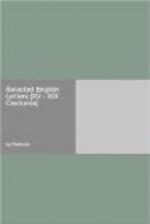When I saw the family (one evening only, and at that time), they were lodging somewhere near Lincoln’s Inn, on the western side (I forget the street), and were evidently in uncomfortable circumstances. The father and mother were both living; and I have some dim recollection of the latter’s invalid appearance. The father’s senses had failed him before that time. He published some poems in quarto. Lamb showed me once an imperfect copy: the Sparrow’s Wedding was the title of the longest piece, and this was the author’s favourite; he liked, in his dotage, to hear Charles read it.
His most familiar friend, when I first saw him, was White, who held some office at Christ’s Hospital, and continued intimate with him as long as he lived. You know what Elia says of him. He and Lamb were joint authors of the Original Letters of Falstaff. Lamb, I believe, first appeared as an author in the second edition of Coleridge’s Poems (Bristol, 1797), and, secondly, in the little volume of blank verse with Lloyd (1798). Lamb, Lloyd, and White were inseparable in 1798; the two latter at one time lodged together, though no two men could be imagined more unlike each other. Lloyd had no drollery in his nature; White seemed to have nothing else. You will easily understand how Lamb could sympathize with both.
Lloyd, who used to form sudden friendships, was all but a stranger to me, when unexpectedly he brought Lamb down to visit me at a little village (Burton) near Christchurch, in Hampshire, where I was lodging in a very humble cottage. This was in the summer of 1797, and then, or in the following year, my correspondence with Lamb began. I saw more of him in 1802 than at any other time, for I was then six months resident in London. His visit to this county was before I came to it; it must have been either in that or in the following year: it was to Lloyd and to Coleridge.
I had forgotten one of his schoolfellows, who is still living—C.V. Le Grice, a clergyman at or near Penzance. From him you might learn something of his boyhood.
Cottle has a good likeness of Lamb, in chalk, taken by an artist named Robert Hancock, about the year 1798. It looks older than Lamb was at that time; but he was old-looking.
Coleridge introduced him to Godwin, shortly after the first number of the Anti-Jacobin Magazine and Review was published, with a caricature of Gillray’s, in which Coleridge and I were introduced with asses’ heads, and Lloyd and Lamb as toad and frog. Lamb got warmed with whatever was on the table, became disputatious, and said things to Godwin which made him quietly say, ’Pray, Mr. Lamb, are you toad or frog?’ Mrs. Coleridge will remember the scene, which was to her sufficiently uncomfortable. But the next morning S.T.C. called on Lamb, and found Godwin breakfasting with him, from which time their intimacy began.




